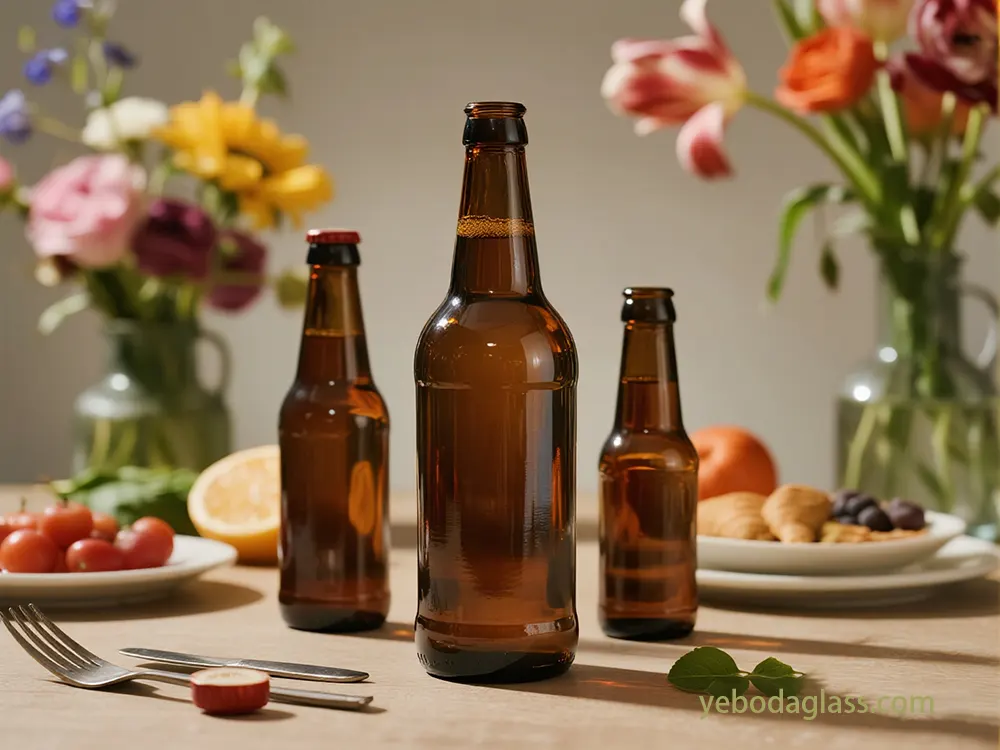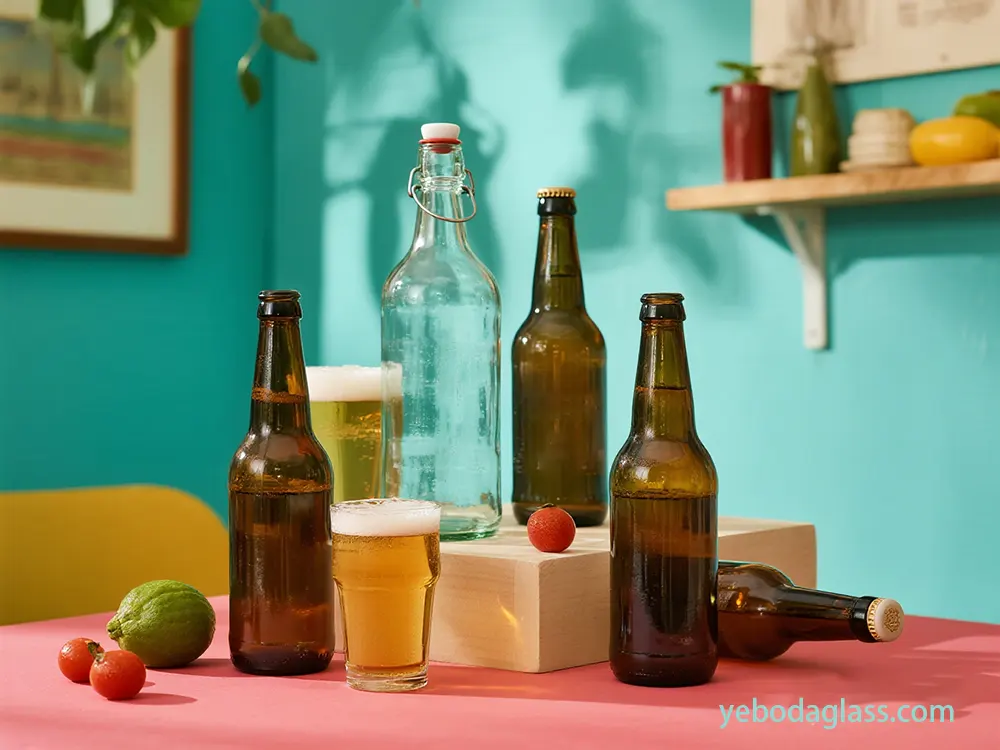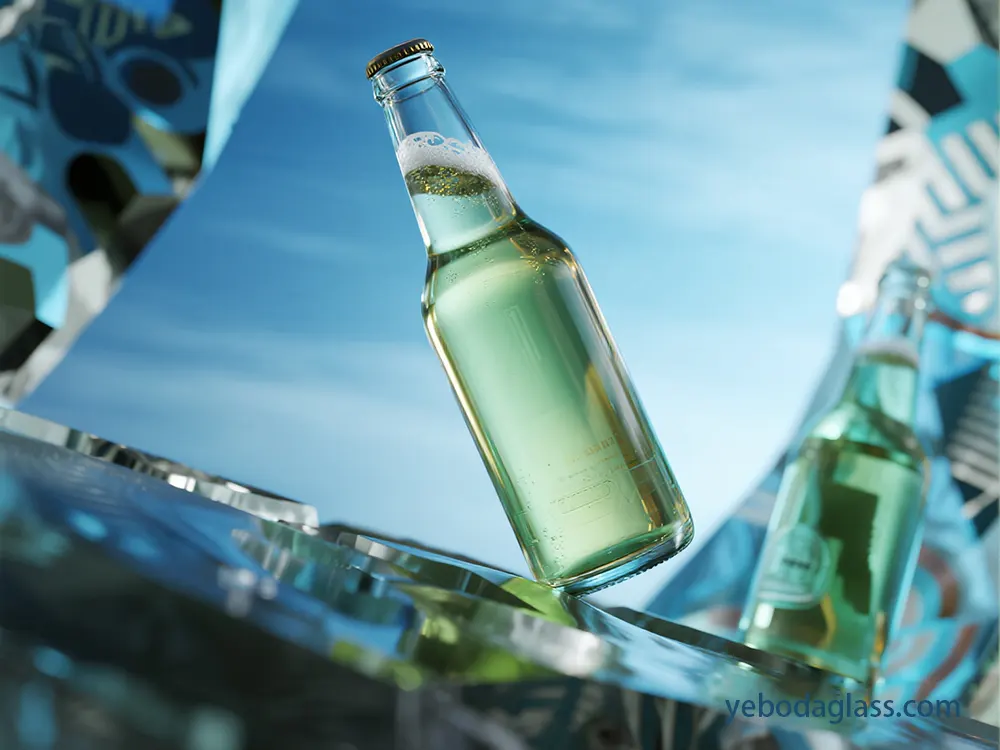This report examines how glass beer bottle suppliers discriminate through innovations in material science, design aesthetics, manufacturing processes and stability. It provides a global perspective on trends and predictions, compares the strategies of industrial and craft brokers, highlights suppliers-brand cooperation, and measure discrimination through consumer perception, market share and premiums.
1. はじめに
Glass packaging is important in the beer industry, holding a major market share (about 50% in 2022) and US $ 22.8 billion (2022) to US $ 31.3 billion to 2030 (3.5% CAGR).Packaging design 60-70% purchases along with buying along with brooking as well as brooking as well as brawings.
2. Glass beer bottle strategic mandatory for innovation
Complex market forces, developing consumer demands, and intensive competition require continuous glass packaging innovation, forcing brands to distinguish beyond liquid.
Major drivers include:
- Premium and Craft Beer Boom: Increasing popularity of craft beer (30%of global consumption) fuel-sanskriting labels and textured demand for unique packaging such as finish.
- Sustainability mandate: Regulatory pressure increases the adoption of environmentally friendly packaging including refillable glass.
- Rising e-commerce: Increased delivery services require durable, leak-proof packaging and branded multipacks.
- 消費者の好みの発展: “traditional” consumers favor glass; Prefer “Abhinav” compartments. Small and female consumers like modern design; Older consumers favor classic aesthetics.
- Increase in emerging economies: China, India, Brazil and Vietnam demand an increase in increasing income beer consumption, field-specific packaging.
- Competitive landscape: Intensive rivalry drives focus on product innovation, recycling, and brand-specific packaging, which exceeds 39.0% market share (2024), underlining the role of packaging in branding.

3. Material science progress for increased performance and aesthetics
Glass materials increase innovation durability in science, reduce environmental effects, and elevate visual/touch appeal, allowing glass beer bottle suppliers to offer different products to suppliers.
Lightweighting technologies have reduced the weight of the bottle by about 30% in two decades, such as 40% decrease in Ardag Group and 150G Longing Cutting CO2 of AB inbave. It reduces transportation costs and environmental footprints. Innovations such as Vetropack’s Ekovai offered a decrease in the withdrawal, mild glass and potential 25% CO2 with friction resistance. The Toyo Glass leads in ultra-lightweight bottles (60% Japanese market share).
Beyond the weight, the glass composition and surface treatment improves performance. Glass provides correct flavor conservation and is endless recycled. New content such as PEF polymer, obtained from natural raw materials, 100% recycling, biodegradability, and provides better taste/carbonation protection on PET.
4. Design aesthetics and form factor innovation
Design aesthetics and form factor innovation glass beer bottles are important to enable specific brand identification and consumer engagement for suppliers. Unique shapes, embossing, custom colors and innovative closures are powerful tools.
Individualizing unique bottle shapes and embossing/debosing and enhancing brand recognition, integrating logo or patterns directly into glass for refinement. These are cost -effective for brands “their” design, especially valuable in North American and Asian markets.
Custom colors protect brand positioning and beer. Amber Glass is traditional and provides excellent UV protection, while clear or green glass visual disintegration and a modern beauty, especially for craft beer.
Innovative closure systems ensure freshness and brands increase personality. The 26 mm PRY is popular for closure. Spiils such as canpieces offer a metal closure with laser printing, unique print, and touch effects. Pilsner Urquell participated with canpac for Bespok embossed cap, emphasizing heritage and stability.
Semi-custom bottles allow signed elements such as embossed logo, an inexpensive way to create unique features. Furious custom bottles provide endless options for size, shape, color and decoration, although they include private mold costs and long -term lead time.
Other trends include minimal design, texture and touch label, and strategic use of weight and texture to express quality (heavy bottles mean high value). Bottle shape and size also impact perception; Long/slim bottles elegance, short/detailed suggestion functionality.

5. Manufacturing process innovation for adaptation and efficiency
Progress in glass production enables bottle suppliers of glass beer to offer unprecedented adaptation, rapid time-to-market, and cost-effective differential design, digital printing, agile molding and automation.
5.1. Direct-to-glass digital printing
Digital printing directly on glass provides unique adaptation and personalization, allowing unique print per bottle to specific locations or events. The O-I (Owens-Illinois) developed industrial-speed digital printing for individual glass packaging.
This method provides more and more design flexibility than traditional screen printing, adjusting unlimited colors and ink layering. O-I glass can also print transparent 3D ink for an embossed effect without physical mold.
Digital printing provides stability benefits, reduces CO2 emissions by 60% and produces less waste compared to traditional labeling. Dyct-to-shape (DTS) digital printing eliminates plastic sleeves/label, reducing environmental footprints.
Technical challenges include ink resistance to uneven glass surfaces and high pasteurization temperature. Advance in ink technology, it is fusing in glass during firing with digital ceramic ink. The global digital glass printing machine market is estimated to reach $ 500 million in 2025. In adaptation, digital printing excel and small-quantity cost-effects, screen printing suits high-volume, durable glass printing.
5.2. Playful molding procedures
Agile enables rapid adaptation to manufacturing design or material changes, ensuring the quality and speed of the product. Rapid prototypening is central, streamlines development from design to production, forms functional molds in days.
Turvic procedures control cost and quality by optimizing the use of materials and reducing flawed parts.
5.3. Automation in glass production lines
Automation changes glass production, increases competition, increases output, and addresses the lack of labor. This involves automatic bottle lines from empty bottle management to filling and palatizing.
Automatic bottling lines typically include conveyors, depleges, filling/capping systems, and case packers.
High-speed lines use professional valves for quick, accurate beer injections, filling thousands of bottles per hour. They offer flexibility and adaptability, handling various bottle specifications and shapes with simple adjustments.
6. Consistency innovation and their brand effects
Bottle of sustainability glass beer is a non-parasical mandatory for suppliers and brokers, which driving innovation that separates brands through environmental stevardship and alignment of consumer values.
Refillable glass bottle systems are growing, operated by circular economy goals. German studies suggest that refillable glass bottles require 25 regeneration cycles within 100 km to be environmentally beneficial. Glass bottles are highly versatile, capable of more than 40 cycles. The life cycle of the re-purpose bottle is 69 times less than a single-use recycling a single-use.
Recycled material integration is important. Environmental efficiency improves by increasing recycled glass and reducing transport distance. The European Union targets 70% glass recycling by 2025 and 75% by 2030. Some wine bottles now use consumer recycled glass (PCRG) up to 100%.
Innovation expands to secondary packaging and carbon footprint reduction. Packaging contributes up to 40% of the carbon footprint of a drink. Lightweight (Section 3) reduces emissions. Environmentally friendly ink and label are adopted. Corona uses the straw six-pack ring of biodegradable barley; Carlsburg uses “Snap Pack” to reduce plastic and discover plant-based packaging. Edible beer labels also emerge to reduce waste.
These stability innovations reduce environmental impact and echo with consumers, especially young demographics, which pay a premium for aligned brands. It promotes loyalty and discrimination.
7. Associate innovation ecosystem: suppliers and alcoholics
Developing Bispoke, market-leading and differentiated packaging depends on strategic partnership, co-construction and technical counseling between glass beer bottle suppliers and brands.
Leading glass beer bottle suppliers actively connect with the brovers. The anchor glass container corporation assisted with custom design, mold development, manufacturing and distribution. The O-I glass, a major global supplier (revenue of $ 6.53 billion in 2024), provides wide catalogs and custom orders, which helps on the scale of brands and stands out with ambitious consistency goals that target 50% recycled materials by 2025.
Other major players include TP glass bottle (wholesale, custom design, logistics) and Ardag group (flexibility, design option, stability, comprehensive stock selection).
Demand for custom glass bottles, especially in premium spirits and craft distillery, underlines the importance of these partnerships. Brands seek custom packaging for discrimination, storytelling, enhanced unboxing and stability alignment.
Suppliers take advantage of advanced molding and design technologies for co-construction, including 3D prototypeings and laser engging. Cass Studies include premium whiskey decoters, Craft Vodka’s custom mat-black hexagonal bottles, and distillery that uses 100% recycled glass with 100% labels.
When selecting a custom manufacturer, alcohol brand experience, MOQ flexibility, stability, design/prototype capabilities, and logistics.companies such as ameri glass bottle (50 years experience) consider expertise in comprehensive solutions.
This collaborative ecosystem really ensures brokers from industrial to crafts, access expertise and technology for discriminated packaging.

8. Brand Segment Strategies: Discrimination between Industrial and Craft Bruers
The strategies of discrimination through glass bottle innovation vary between large industrial liquor makers and tight crafts, which are powered by scale, budget, target consumers and risk. However, both sections show convergence on major trends.
8.1. Shared trends and convergence
Both industrial and craft brooers adopt rapidly sustainable packaging (light, recycled glass, environmentally friendly ink/label). Corona’s biodegradable ring, Carlsburg’s “Snap Pack”). Functional packaging (grip-friendly, receilable) enhances user experience. Commerce requires strong packaging 58. Finally, the enhanced reality (AR) labels and QR codes provide interactive materials and social media engage.
8.2. Craft liquor making strategies
Craft brooaries focus on hand -flowing, quality ingredients and innovative tastes, which target consumers seeking unique tastes and individual stories. Their strategies are agile and experimental:
- Specialization and local identity: distinct beer styles or different by local identity.
- Strong brand identification: important, unique names, logo, typography, texture and colors to stand out.
- Special release and unique form: Continuous looks for limited versions to generate enthusiasm.
- Promoting the values of the company: actively promote stability and community participation to appeal to socially responsible consumers.
- Personal Connection: Packaging makes connections through limited-culture artwork, seasonal design and regional subjects.
- Adaptation and privatization: Offer a custom-crushed label for events.
Interactive Packaging: QR code provides access to video, playlist or other materials. - Marketing budget: usually 5-10%revenue (large craft: 10-15%; Startups: 12-20%), with packaging as an important communication tool.
- Consumer Inspiration: Craft beer seeks consumer knowledge, new taste experience and departure from mainstream beer.
8.3. Industrial liquor making strategies
Large-scale industrial broovers focus on mass-market appeal, standardized cuisine and broad brand awareness.
- Mass-Market Appeal: Packaging resonates with a comprehensive consumer base, often depends on the identified brand elements.
- Challenges of discrimination: Traditional beer often struggles with discrimination, sometimes considered as simple, social, traditional and good values.
- Spogenous and partnership: Comprehensive sponsorship and partnership brands increase visibility.
- Evolving Positioning: To appeal to broad segments, there is a need to develop a position beyond the generic “craft beer”.
- Pay attention to the flagship brooze: focus on strong, marketingfall flagship brruges for comprehensive distribution and frequent recognition.
8.4. Consumer division and packaging preferences
“Traditional” consumers are loyal to glass bottles; “Abhinav” prefers aluminum cans. Small and female consumers prefer modern packaging; Older consumers favor classic design.
While the glass remains prominent, more brooariies detect metal packaging, highlighting the need for a bottle suppliers of glass beer to innovate continuously for competitive discrimination.
9. Measuring brand discrimination: Consumer perception, market share and impact on premium
Measuring the effect of packaging innovation on brand discrimination is important for alcohol makers to justify investment. This involves analyzing consumer perception, market share profit and improvement in premium pricing.
9.1. Impact on consumer assumption
Packaging design strongly affects consumer perception, affecting 60–70% of purchasing decisions. 64% of consumers try new products due to packaging, and 41% purchases repeat. For beer, 72% of the shopkeepers are more likely to buy beer due to its packaging.
Specific design elements have quantitative effects:
- ラベルデザイン: Layout affects the intention of constantly purchasing craft beer. Madern labels attract more attention.
- Color schemes and bottle size: A “bomber” bottle with a warm label color scheme optimizes consumer preferences.
- Pictures and nomenclature: Pictures, especially human faces, attract visual attention. Descriptive naming appeals by referring to the flavor.
- Weight and texture: Heavy bottles express high quality.
- サイズとサイズ: Long/thin bottles removed elegance; Suggest short/detailed functionality.
- Large order scale benefits from the economies of the scale, reducing the cost per unit. Glass is the most traditional and premium beer packaging, preserving quality, taste and aroma.
The product/brand with multicencary packaging design values and enhances the taste. Picking also works as a medium of a story saying, in which consumers want to taste notes, materials and brand stories on labels.
9.2. Contribution to market share and premium
The tendency of premiumment in beer increases the use of high-quality glass bottles for premium brruges, accounting for 20% of the total bottle consumption. The market for beer bottles, which is priced at USD 2747.7 billion (2024), estimated that by 2033, new eco-friendly design in USD 4373.4 billion (5.3% CAGR) 2023-2024. North America has 25% market, while Asia-Pacific shows an increase of 40%.
While bottled beer stakes 45.7% revenue in 2024, canned beer is also increasing. This competitive landscape requires continuous innovation from glass suppliers.
9.3. Procedure for measurement
To determine the amount of discrimination, use bottle suppliers of brooors and glass beer:
- Neuromarcating technology: Provide purpose data on visual attention.
- A/B testing: Packaging for traffic and engagement compare designs or shelf placements.
- Sale Data Analysis: New launch for link packaging redesigns or market share and sales.
- Consumer Survey and Focus Group: Perceptions of quality, premium and brand alignment.
- Pricing analysis: It determines that the new packaging enables premium pricing.
The systematic application of these techniques provides actionable insight to separate brands in glass bottle innovations, leading to an increase in consumer preference, market share and premium pricing.
10. Future approaches: Emerging trends in glass beer packaging and future innovation
The future of glass beer packaging will be seen in transformational progress, consumer preferences and stability will be observed. Glass beer bottle suppliers will lead these forecast innovations, further offering brands of discrimination opportunities.
10.1. Smart packaging technologies
Smart packaging technologies will bring revolution in consumer engagement and transparency.
- Promotional reality (AR) Integration: The third Arora uses image recognition to project virtual experiences on bottles through platform smartphone scans by the third Arora. It enables direct-to-conjumer channels, publicity, sales, social media connections and inventory activation. Craft beer is ideal for AR, which promotes brand awareness and love.
- Interactive packaging with QR Code and AR: QR code will continue to provide access to brooing information, exclusive materials, and publicity.
- Temperature-sensitive ink: Smart packaging will include ink which changes the color to indicate optimal drinking temperature.
- NFC Chips: Embedded chips in packaging near pass field communication (NFC) will allow the detailed product information and smartphone tap for authenticity verification. These chips are important for brand safety, original check, anti-counterfiting, and supply chain visibility.
Global beer packaging sector, US $ 28.7 billion (2024) is expected to grow from $ 40.5 billion to 2034 (3.5% CAGR), it is partially operated by premium beer packaging using ‘smart’ and interactive elements.
10.2. Advanced materials and manufacturing
- Nanotechnology: Nanotechnology can offer future applications for beer bottles emerging in food packaging.
- Self-cheating bottle (speculative): While seen in the compartment, self-practice techniques can be compatible with speculative, glass bottles, provide important features.
- Increased durability and lightweight: The structure of the glass and continuous progress in the tempering will reduce the weight of the bottle while increasing the durability, making the glass more competitive. The Ekovai technology of vetropack gives an example of this.
- Continuous content integration: 100% post-consumer recycled glass (PCRG) will become standard, and new biodegradable coatings or closure composes may emerge.
10.3. Regulatory and economic landscape
- Patent Box Scheme: Innovation companies in packaging can benefit from schemes like UK patent boxes, patent innovation offers low corporation tax rate (10%) on profits, which encourages R&D.
- Circular Economy Mandate: Strict regulations that promote circular economy principles will accelerate refillable and highly recycled glass solutions, which will push the glass beer bottle suppliers to collect, wash and reuse the infrastructure.
The future of glass beer packaging is dynamic, to connect with consumers to take advantage of rapid smart, durable and customized glass solutions with brands and gain a competitive edge.
11. Conclusion
Innovation in glass beer bottles unevenly display that glass beer bottle suppliers are important in driving brand discrimination. The progress of material science produces light, more durable and aesthetic pleasing bottles. The state -of -the -art design includes unique shapes, complex embossing and innovative off, causing packaging to become a powerful brand ambassador.
The manufacturing process innovation, especially direct-to-glass digital printing and agile molding, has democratized the optimization, enabling both industrial and craft brooers to designed efficiently. Stability-powered innovations, which include increased strong refillable systems and recycled materials, reducing environmental impact, and compensating with modern consumers, promoting loyalty and enabling premiums.
A collaborative innovation ecosystem through strategic partnership between suppliers and alcoholists fuel these progresses. Industrial broovers using leverage scale, while crafts using brooariies agility and storytelling. The average impact on consumer perception, market share and premium underlines the strategic importance of these innovations.
Further, integrating smart packaging technologies such as enriched reality and NFC chips, with constant progress in sustainable materials and manufacturing, promises another more interactive, transparent and environmentally responsible for glass beer packaging. A composite, active approach by glass beer bottle suppliers and associate liquor continued to shape the bottles of glass beer to the next generation, ensuring their significant and dynamic role in brand discrimination.




